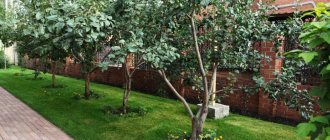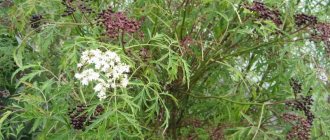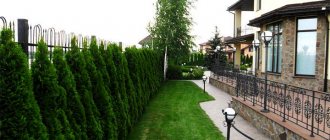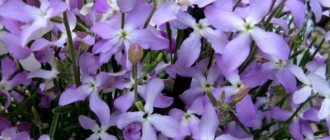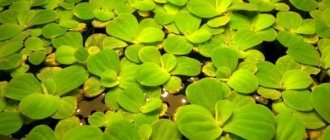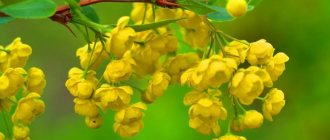Laconicism, restraint, sophistication, mystery, naturalness of materials, a real work of art from the distant East... All this is a Japanese-style garden - a new product, already loved by many gardeners in temperate climates.
The principles of organizing a Japanese garden (originally a private temple park) were developed back in the 8th century in the Land of the Rising Sun, and appeared outside its borders only in the twentieth century. Our lovers of man-made views of nature appreciated not only the decorativeness and unusualness of this style, but also its hidden philosophy.
Living in harmony with nature, reverent reverence for all its manifestations and the ability to see beauty in the smallest things - these are, perhaps, the main principles of the Japanese garden. Why not try to build a corner of such peace on your site? Anyone can do this!
- Japanese-style garden - a new country “philosophy”
Do you want to get to know Japanese philosophy better and create something extraordinary on your site? Then our Japanese garden guide will help you.
And we will help you navigate the range of plants suitable for a Japanese-style garden. Moreover, not all trees, herbs and shrubs, which are classics for this type of garden, feel good in our climate. So together we will figure out which plants to choose, what is suitable, and what to replace with what, without disturbing the aesthetics of the Japanese garden.
Shapes and silhouettes of a Japanese garden
Rounded and slightly flattened shapes of tree crowns, as well as silhouettes of large boulders, mounds and bridges are a priority. In their homeland, such hemispheres everywhere symbolize “rounded mountains.”
So you will have to not only select the appropriate types of predominant trees, but also closely engage in their shaping cutting. The dominant feature of a garden in this style can be certain types of thuja, pine, spruce, fir and hemlock - when purchasing, ask the nursery how your tree will grow.
Don’t forget, many conifers grow into huge trees - for a small area, one such well-placed and formed evergreen plant may well be enough as the main core of a Japanese garden.
- Niwaki: Tree Trimming Workshop
Japanese-style garden: mastering the technique of trimming nivaki trees.
Also quite in the oriental style, trees are multi-trunked or with “weeping” flowing crowns - such as those of larches, fir, birch, and elderberry.
Plants such as Japanese spirea, brilliant cotoneaster, dwarf mock orange, privet, cinquefoil, barberry, stephanandra incised leaf, and euonymus “hold” hemispherical pruning well.
Japanese larch
A deciduous coniferous plant from the pine family grows in some regions of Siberia, Sakhalin and Japan. It reaches a height of 35 meters, and the diameter of the trunk is from 50 to 100 cm. The tree is a long-liver and can live 500 years.
Its long, thick, almost horizontally located branches form a wide pyramidal crown. They are covered with shiny blue-green needles, reaching 5 cm in length, which turn bright yellow in autumn.
The cones of Japanese larch are spherical in shape and colored in greenish tones; they remain on the tree for up to three years and form small light brown seeds. The fast-growing tree annually adds 10-15 cm in width and 25 cm in height; it is resistant to diseases and pests.
Larch has a deep root system, which provides it with high wind resistance. It is recommended to plant the tree to a depth of 70-80 cm. During the summer heat, young seedlings need to be watered 1-2 times a week, loosened and weeds must be removed.
Sakura? Sakura! But not only…
Decorative foliage, as well as unexpectedly bright color spots of flowering trees and shrubs, are desirable in a Japanese garden.
A riot of colors is welcomed here twice a year - in spring and autumn. In spring, cherry blossoms and azaleas set the tone in Japanese gardens.
Sakura is the calling card of the entire country. Do you know that this is not one, but more than a dozen plant species? Moreover, not only cherries are considered sakura, but also plums and bird cherry! Not all of them are suitable for our region - but it doesn’t matter, many equally decorative flowering trees will successfully replace an oriental beauty in your Japanese garden. Some of the species listed below can withstand frosts of -45°C - you will not find more winter-hardy plants.
So, instead of pampered sakura, we plant on our site flowers that are in no way inferior to it in beauty and abundance of flowering:
- zoned varieties and hybrids of cherries (felt, Kuril, Sakhalin, sharp-serrated, etc.);
- plum – Ussuri, Chinese, apricot, cystene, etc.;
- decorative varieties of apple trees;
- steppe almonds or Ledebour almonds;
- Louiseania.
Also in spring you will be pleased with the colorful blooms of numerous types of hawthorn (soft, blood-red, prickly, Morden, etc.), bird cherry and lilac, quince, spirea, pieris, cinquefoil, and kalmia.
Azaleas (some beautifully flowering species of the Rhododendron genus) are also one of the hallmarks of a real Japanese garden. Not all varieties are suitable for cultivation here, but only truly winter-hardy deciduous varieties - experts advise paying attention to the varieties of the Northern Lights Azalea Hybrids series, created in the western USA. Yes, and you will have to tinker with them to ensure the proper conditions (light acidic soil, high humidity, shelter for the winter, regular pruning of young plants).
- Winter-hardy rhododendrons - 10 most beautiful varieties with photos and descriptions
Frost-resistant rhododendrons for open ground.
Conclusion
Friends, as you can see, plants for a Japanese garden can be found in the middle zone. Many conifers, shrubs and trees grow well here. Japanese maples can only survive under cover, although winters have now become so mild that you can try growing them too.
All types of dwarf conifers that winter in our climate are suitable for a Japanese garden.
Herbaceous plants include low ground covers, ferns, hostas, astilbes, Japanese anemone, and peonies. Sakura can be replaced with cherries, plums and three-lobed almonds. The real “Japanese” ones grow well among our shrubs: barberries, spireas, hydrangeas and weigelas.
But it is important not to forget that you should not get too carried away with collecting vegetation. You need to observe conciseness and restraint, like the Japanese. That's all I have for today. Natalya was with you.
PS What do you think about Japanese gardens? Do you like them or do you prefer traditional ones: with bright flower beds?
Perennials and annuals in the Japanese garden
However, not only trees and shrubs bloom in spring. Although flowers as such are almost never found in the traditional Japanese garden, there are two exceptions - irises and chrysanthemums.
Iris leaves symbolize samurai swords, and their graceful, delicate flowers with a hundred shades will help you create compositions in almost any color scheme. Typically, irises are planted in large groups near bodies of water. The only “but” is that Japanese irises are too heat-loving for our gardens, so feel free to replace them with more resistant Siberian ones.
- Bearded and beardless irises: names of species with descriptions and photos
Do you want to plant irises of different colors, but don’t know which ones are best? We have collected all types in our material, from dwarf to the tallest.
The second most important plant among the “national Japanese” perennials is the chrysanthemum, a symbol of the sun. With proper care, it has long, abundant and colorful flowering. In addition, it has an unimaginable number of shapes and shades of inflorescences.
- Chrysanthemums - how to grow a healthy plant?
We answer 3 main questions about chrysanthemums.
In addition to chrysanthemums and irises, some astilbes and hostas would be appropriate in Japanese gardens. These perennials are also planted in groups near ponds or in shady corners.
As for herbs and grains, they are not alien to the Japanese garden. Pay attention to miscanthuses - almost all of them have a long period of decorativeness from spring to late winter. And in the fall they turn into unusual colors. For our latitudes, Chinese, giant, and sugar miscanthus are suitable - just don’t forget to check the winter hardiness of the variety you like.
Dense hummocks form Dihanthelium latectum and Spodiopogon, while Hakonechloa grows in magnificent tufts. Despite its non-Japanese origin, reed reed grass, wolfsedge and smooth sedge, hesperostipa, and slender-legged gray will fit perfectly into such a garden.
Trichosanth japonica
An annual herbaceous vine whose pumpkin fruits resemble a serpentine cucumber, twisted in a spiral or ring. The plant grows in tropical and subtropical climates and is eaten by local residents as a green vegetable.
Its thin stem reaches 3-4 meters in length, its leaves have from 3 to 7 lobes. Snow-white flowers with a diameter of about 4 cm resemble snowflakes in appearance; unusual long thread-like processes extend from their petals, twisting into a spiral. In the evening, the flowers begin to emit an unusual delicate aroma with notes of jasmine, reminiscent of an expensive perfume.
Trichosanth fruits reach up to 1 meter in length and 10 cm in width, and as they ripen, light stripes appear on them. They are covered with thin skin, their flesh is white, tender and slimy. The fruits of the Japanese variety of trichosanthus acquire red-orange shades at the ripening stage.
The harvest of this fertile crop is eaten unripe; the young fruits taste like a crunchy cucumber with a sweet radish flavor. Japanese trichosanth is planted in open ground no earlier than June 10, since the plant is heat-loving and does not tolerate cold weather. If the temperature reaches less than +10 degrees, the vine dies. Therefore, it needs to be planted in the sunniest and warmest place, preferably near the southern wall of the house.
Colors and shades of the Japanese garden
If we are already talking about colors and shades, let us remember that decorative foliage species are one of the priorities of the Japanese garden. If the flowering time of most plants occurs in the spring, then trees and shrubs with bright, unusual foliage come to the fore in the fall, which is especially valuable in our not too sunny latitudes.
In this regard, the maple reigns in the classical Japanese garden - a symbol of life wisdom, greatness and eternity itself. Alas, the incredibly picturesque Japanese maples are not for our latitudes. It is rare that a gardener will be able to find the place and conditions to grow this heat-loving miracle in full size here. What to do? Replace it with other species that are stable and winter well in our country. For example, false siebold maple, ginnala maple, Manchurian maple, silver maple - they will delight not only with bright colors, but also with beautifully dissected foliage.
However, not only maple is decorative deciduous. Such colored foliage accents can be successfully created on your site by brittle buckthorn, purple-leaved apple trees, some varieties of bird cherry, red and black elderberry, and even not well-known species of birch trees with split leaves of an unusual dark red color.
Many varieties of euonymus, serviceberry, bladderwort, and hawthorn will look bright spots in a Japanese garden. “Lianas” are also suitable - various types of grapes (maiden, Amur, etc.), clematis, lemongrass, three-winged grapes, princes.
What real Japanese plants can be planted in the middle zone
Of the real “Japanese” I can recommend paniculata hydrangea. It is unpretentious and has many varieties. Bretschneider's hydrangea is also suitable for our purpose. This is a tall plant. I wrote in detail about caring for all hydrangeas here.
Winged euonymus is a small tree or shrub that attracts attention with the red color of its autumn foliage. With proper care, tree peonies grow well here, including those of Japanese selection.
With proper pruning, weigels and forsythia grow and bloom in our climate; in general, they are completely unpretentious shrubs. Even more unpretentious and very beautiful are barberries in all their variety of varieties, Thunberg spirea, Nippon, Japanese and willow.
A completely unpretentious Japanese quince has been growing in my garden for many years. It blooms well and produces healthy fruits. Maintenance requires pruning, sometimes even in summer, as it grows so wide. It should be borne in mind that it has thorny branches, so if you don’t like messing with thorns, it’s better not to grow this shrub.
Reproduction, planting and care of shrubs in the Moscow region
The culture is quite unpretentious. Reproduction is carried out mainly by cuttings during spring pruning of bushes. Rooting cuttings is not difficult even for novice gardeners. Proper planting and care of shrubs in the Moscow region are presented in detail later in the article.
The basic rule is the choice of place for planting Japanese kerria - the shrub prefers bright sunny places, without the influence of strong winds. In partial shade, the color of the foliage may change, and the shoots may become strongly elongated. Due to this, decorative properties are lost. The soil must be sufficiently fertilized with organic and mineral substances. It is very important to dig a deep trench up to 1.5 meters deep before preparing the planting site. Broken brick or coarse gravel is laid at the bottom in a layer of up to 70 cm. Then a layer of organic humus is laid up to 30 cm. The remaining space is filled with planting soil. After this, the holes are prepared and Japanese kerria is planted with grown and rooted cuttings.
Proper care of Japanese kerria includes regular watering (the soil should not dry out to a depth of more than 10 cm). Every week mineral fertilizing is carried out with special preparations for ornamental and flowering crops. They are added to water for irrigation.
For propagation, apical shoots up to 6 cm long should be taken. They are cut with sharp pruning shears and placed in water with the addition of succinic acid tablets. This drug is diluted at the rate of 4 tablets per 1 liter of water, stimulates the process of formation of the root system. After small roots appear, the cuttings go deep into the ground on a separate tree. They can be covered on top with small improvised greenhouses. In the fall you will get ready-made seedlings. But they should be planted in a permanent place only in the spring.
tree peony
The culture is a shrub up to 2 meters high, with huge fragrant buds. The tree peony is a relative of the herbaceous peony, only its stems are much stronger, but it is also decorative. The leaves are pinnate, large, openwork. Flowers of various colors, up to 20 cm in diameter, double varieties are especially attractive.
Tree peony tolerates winter well. He loves well-lit open areas, shelter from the wind, and loamy soil. Timely watering and fertilizing are necessary, especially during flowering.
- Author: iarriba
Rate this article:
- 5
- 4
- 3
- 2
- 1
(0 votes, average: 0 out of 5)
Share with your friends!
Visiting rules
Iva Park is a private space. Therefore, certain rules apply within the park:
- Paid entrance. For adults - 500 rubles, for schoolchildren, students and pensioners - 300 rubles, for preschoolers - 150 rubles, for children under 3 years old - free.
- You can only enter the garden with a guide. On weekdays, excursions take place every two hours: at 12:00, 14:00 and 18:00. On weekends every hour from 12:00 to 18:00.
- Up to 12 people can attend one excursion. The park has narrow paths, and if there are more people, not everyone will be able to hear the guide.
- You can sign up for the excursion in advance on the Iva Park website. It is better to do this in advance, since in summer excursions are scheduled a couple of weeks in advance.
I was lucky: there were only two people on my excursion besides me, so I walked around the park almost alone.
Lavrovishnya
The short tree was very popular in past centuries, but then it was rarely grown. Its leaves resemble laurel, and its berries resemble cherries, hence the name. The tree grows up to 10 meters, with a dense compact crown. The foliage is rich green, leathery, shiny. The white flowers have a pleasant strong aroma and bloom in April-May.
Caring for cherry laurel is simple. Watering as needed, loosening, weeding, fertilizing according to schedule. The culture is beautiful for decorating a site, but you need to remember that it is poisonous.
Reproduction of pieris bush: from seeds, cuttings, layering and root shoots
Reproduction of Pieris shrub
The plant does not cause any particular difficulties in propagation. This process can be performed in several ways, each of which has its own characteristics. Here are the types of propagation of the pieris bush:
Growing from seeds:
- To begin with, you should purchase planting material of the desired variety.
- After purchasing the grain, inspect and sort it out so that there are no substandard raw materials among them.
- When the preparatory procedures are completed, you can sow the grains in the ground, which consists of peat, coniferous soil and coarse sand (it can be found on the river).
- It is recommended to sow planting material in March. Spread the grains on the surface of the ground and lightly sprinkle with soil mixture.
- A film is placed on top of the container, after which the containers themselves for growing seedlings are placed in good lighting conditions.
- For full growth of seedlings, room temperature is quite suitable.
Propagation by cuttings:
- Pieris propagation by cuttings is usually carried out in August.
- But in order for the culture to take root well, it is recommended to cut off the pagons when they have reached a length of 10 centimeters .
- Treat the cut area with phytohormones, then place it in pots filled with specially prepared soil mixture.
- Planting material needs moderate moisture, and it is not necessary to cover the container in which the cutting is located.
- Cuttings take root quite quickly and do not require additional care.
Reproduction of Pieris by layering and root shoots. These Pieris propagation methods are implemented in the following ways:
Using layering:
- You need to select a pagon for further use as planting material in the lower part of the crown.
- It is recommended to do the procedure at the very beginning of summer.
- The shoot should be bent to the ground and secured with a bracket so that it does not return to its original position.
- Sprinkle it with soil in such a way that the top remains above the surface of the soil ball.
- Layerings form a root system over 1-2 growing seasons , after which they can be separated from the mother bush and transplanted to a pre-selected place in the garden.
Reproduction by root shoots:
- It is dug up in the spring, before the start of the active growing season of the plant.
- Although such manipulation can also be performed during the early autumn season - then the shrub will have time to take root before the onset of the next growing season.
You can choose any of the methods of propagating Pieris - each of them is good in its own way, and besides, none of them requires too much effort.
Techniques for designing a landscape composition
When designing a Japanese garden in a country house, the following techniques are used:
- bright colors are expressed in one dominant shade. This is usually pink or red, used in small quantities as bright accents;
- The highlight is the numerous paths and stones covered with moss, dry twigs, ponds with water lilies;
- the predominance of asymmetrical forms with one accent;
- mandatory harmony of stones and water;
- natural beauty and straight lines;
- restraint of the color palette.
When designing a site in Japanese style, special attention is paid to:
- absence of sharp corners. All slopes are made smooth and semicircular;
- the presence of inclined, flat and stepped stones, which are placed both vertically and horizontally;
- lack of cubic and overly regular shapes.
Forsythia
A small, early flowering shrub widely distributed in Japan and China. It is one of the first to bloom and blooms with a bright yellow color. The buds appear on it before the leaves, so during flowering the tree looks like a golden ball.
Some varieties of forsythia grow successfully in European climates. The culture loves bright light, but can also grow in the shade. It goes well with conifers or lilacs. Forsythia does not tolerate an abundance of moisture, tolerates drought well, and needs shelter for the winter.
Hydrangea
A lovely, exquisite plant that has become a favorite of many gardeners. It can decorate any landscape. It is not for nothing that hydrangea is very popular in Asia and Japan - there some specimens grow to large, lush sizes. The hydrangea genus has more than 50 species. Therefore, you can choose any varieties of different shapes, sizes and colors you like.
The culture needs a lot of light and space, shading during the midday hours, and loose, moisture-permeable soil. Hydrangea is pruned in spring, summer and autumn. In frosty winters they provide shelter from the cold.
Wisteria
With the help of blooming wisteria, you can recreate a piece of a real Japanese landscape. After all, this vine with flowing inflorescences comes from the east. But it has successfully taken root and is grown in other countries.
During flowering, wisteria emits a very pleasant smell, so with its help you can create real flowering arches, gazebos, and relaxation corners. It needs moist and well-fertilized soil; it is advisable to choose a well-lit place for planting. The shoots grow very quickly and need strong support. The crown must be pruned several times a season - this is the secret of the lush flowering of the vine.
Irga
The shrub is very decorative, with a wide crown and thin branches. It grows like a bush or small tree and is easy to shape. In spring, white or pale pink flowers appear on it, which are then replaced by sweetish edible berries.
The plant is easy to care for, it requires minimal watering and tolerates winters well. If there is a pond in the garden, shadberry can be planted near it. It is also used for planting along a fence or as a hedge.

